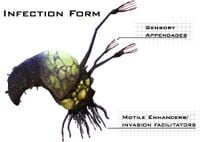Infection Form: Difference between revisions
From Halopedia, the Halo wiki
No edit summary |
mNo edit summary |
||
| Line 1: | Line 1: | ||
[[Image:BabyFloodCloseup.jpg|right|thumb|200px|The Infection Form in game]] | [[Image:BabyFloodCloseup.jpg|right|thumb|200px|The Infection Form in game]] | ||
[[Image:Flood3.jpg|thumb | [[Image:Flood3.jpg|thumb|200px|Artistic view of Infection form]] | ||
[[Image:Infectionforms Halo1.jpg|thumb|200px|The Flood feeding on a Grunt and Elite]]The Flood falls under the Kingdom ''Protoctista'', Phylum ''Protozoa'', Sub-Phylum ''Apicomplexa'', and evolved from mutualistic protozoa colonies over time, different sub-species developed. Each sub-species with their own adaption that can support the rest of the colony. Over more time the colonies must have evolved into complete organisms; they no longer consist of specialised protozoans, their tissue consists of highly evolved cell types that are new to science. | [[Image:Infectionforms Halo1.jpg|thumb|200px|The Flood feeding on a Grunt and Elite]]The Flood falls under the Kingdom ''Protoctista'', Phylum ''Protozoa'', Sub-Phylum ''Apicomplexa'', and evolved from mutualistic protozoa colonies over time, different sub-species developed. Each sub-species with their own adaption that can support the rest of the colony. Over more time the colonies must have evolved into complete organisms; they no longer consist of specialised protozoans, their tissue consists of highly evolved cell types that are new to science. | ||
Revision as of 01:52, December 28, 2006
The Flood falls under the Kingdom Protoctista, Phylum Protozoa, Sub-Phylum Apicomplexa, and evolved from mutualistic protozoa colonies over time, different sub-species developed. Each sub-species with their own adaption that can support the rest of the colony. Over more time the colonies must have evolved into complete organisms; they no longer consist of specialised protozoans, their tissue consists of highly evolved cell types that are new to science.
They are currently capable of motile motion, respiration, sensation, excretion, assexual reproduction. The spore Flood form is nearly harmless at first glance, but once it gains physical contact with a biological host it becomes highly virulent. Small tendrils underneath its "body" penetrate the skin and unleash an attack on the host's nervous system. First, it paralyzes the host's body. Once this is accomplished, it rewrites the neural pathways of the victim's brain with it's tendrils, forcing a resonant frequency match between its neural signals and the host's. Then it releases Flood DNA which overwrites host DNA and causes the host to mutate. When this is done, it starts to edge its way into the body, slowly moving organs out of the way so it can nest itself into the chest cavity of its host. If a match cannot be obtained, the host is left alone and cannot be used.
At this time, the only known subject to be incompatible with Flood Infection Forms is Sergeant Johnson, due to his being in an incident involving a crate of Plasma Grenades, using them to hold off Covenant squads while awaiting reinforcements and contracting Boren's Syndrome from the residual radiation.
In Halo 2, they can revive fallen but un-dismembered Combat Forms by burrowing into them, greatly increasing their threat level. If the player inflicts enough damage to the prone Combat Form it will disintegrate completely and become useless (Grenades/explosives are most effective, Energy Swords and the Brute Shot melee are also found to be effective).
| |||||||||||||||||||||||||||||||||
